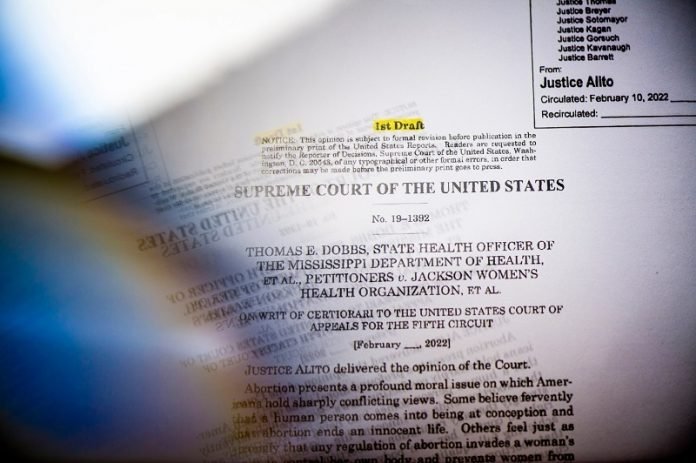
As the implications of a draft Supreme Court decision that would overturn the landmark abortion-rights cases Roe v. Wade and Planned Parenthood of Southeastern Pa. v. Casey reverberated around the United States—and around the world—one question that remains is:
Who leaked the document?
Indeed, it was a shocking breach of Supreme Court protocol.
In a statement circulated by the Supreme Court press office, Chief Justice John Roberts describes it as “a singular and egregious breach of that trust that is an affront to the Court and the community of public servants who work here.”
Journalists from POLITICO, the news organization that obtained and reported on the draft opinion, write that: “No draft decision in the modern history of the court has been disclosed publicly while a case was still pending.”
POLITICO obtained the draft majority opinion for a case, Dobbs v. Jackson Women’s Health Organization, that has widely been watched as a bellwether for abortion rights in the U.S., and published it in full on Monday evening.
On Tuesday, the Supreme Court press office verified its authenticity with a statement that read, in part, “Although the document described in yesterday’s reports is authentic, it does not represent a decision by the Court or the final position of any member on the issues in the case.”
Still, the majority opinion, written by Justice Samuel Alito, offers striking insight into the court’s stance on abortion rights—and perhaps a few clues as to who leaked the document, says Dan Urman, director of the Law and Public Policy Minor at Northeastern, who teaches courses on the Supreme Court.
POLITICO reports that it obtained a copy of the draft opinion “from a person familiar with the court’s proceedings in the Mississippi case along with other details supporting the authenticity of the document.”
In the statement provided by the Supreme Court press office, Roberts says he has “directed the Marshal of the Court to launch an investigation into the source of the leak.”
As of Tuesday, the person or people who leaked the document had not been identified. But Urman laid out a few theories about who it could have been.
Theory No. 1: Liberal justice or clerk
Perhaps the first place to start, when considering who might have leaked the opinion, is with the liberal Supreme Court justices and their law clerks—the people who would be in the minority of this opinion, Urman says.
“The initial reaction is that someone in the liberal chambers could have leaked this to galvanize opposition to the opinion,” he says. “If you believe that, you might also see [President Joe] Biden’s response as a coordinated effort—a kind of alley-oop to the leak.”
On Tuesday, Biden called on Congress to pass legislation that would codify the right to abortion. “If the Court does overturn Roe, it will fall on our nation’s elected officials at all levels of government to protect a woman’s right to choose,” he said in a written statement.
Vice President Kamala Harris, in a similar statement released on Tuesday, called upon voters to “fight for women and for our country with everything we have.”
The problem with this theory, Urman says, is that Supreme Court clerks are “incredibly risk-averse.” A leak of this magnitude could be a “career-killer,” particularly considering advances in technological forensics that may enable investigators to see who printed or sent the document.
Theory No. 2: Conservative justice or clerk
If the leak didn’t originate in the liberal chambers of the court, perhaps it came from the conservative chambers.
In this theory, conservatives embarked on a two-part strategy to soften the blowback they expect when the court releases its final decision this summer and to lock in the votes as they are, Urman says.
Under this theory, conservatives would be counting on quick-moving news cycles to diffuse public backlash to the final opinion.
“By June, when the opinion comes out, we would all be thinking, ‘Didn’t we know this already?’” Urman says.
At the same time, the draft opinion creates a record that, at least in February (when it was written), there were enough votes among Supreme Court justices to overturn Roe completely. This could dissuade justices who might have been open to a more moderate approach from changing their stance before June (when the final opinions are expected).
POLITICO reports that, according to “a person familiar with the court’s deliberations,” at least four of the other Republican-appointed justices had voted with Alito in conference after oral arguments in the case: Clarence Thomas, Neil Gorsuch, Brett Kavanaugh, and Amy Coney Barrett.
“Historians have found examples of opinions that started one way and ended up going another way,” Urman says. “This could be seen as a conservative trying to lock in the opinion as is.”
Theory No. 3: Chief Justice John Roberts
Taken another way, the leaked document could serve as a warning shot from Roberts to other more moderate conservative justices, Urman says.
POLITICO’s publication of the opinion sparked immediate protests from abortion-rights activists, who, within hours, had gathered by the hundreds to protest outside the Supreme Court building in Washington, D.C. Protests continued on Tuesday across the country.
Under this theory, Roberts may have leaked the document as a preview of what such an extreme ruling on Roe might entail for the justices who signed on to it: A galvanized public wouldn’t shy away from “making life difficult” for the justices whenever they’re in public, Urman says.
Tipping his hand could have been an effort to sway a few justices toward a more moderate approach to the Mississippi case, Urman says.
However, this theory’s unlikely to be true, given Roberts’ focus on preserving the court’s legitimacy, Urman says.
“Roberts reminds me of the head of a dysfunctional household, where chaos reigns behind closed doors,” he says. “It doesn’t seem to make sense for the head of the household to leak all that is going on, when that person cares about the institutional legitimacy of the court.”
Theory No. 4: Disgruntled employee
In what would be the most dramatic turn of events, perhaps the person who leaked the document was simply an employee in the building—someone taking out the recycling, or scanning documents, who caught a glimpse of the draft and felt duty-bound to share it with the press.
While this scenario would be the kind of underdog whistleblower tale that makes for a great Hollywood blockbuster, this theory ultimately seems unlikely as well, Urman says.
If the ruling in its final form remains largely as it is in this draft, it will have drastic and wide-ranging implications for millions of people across the country. At the same time, the leak itself will have long-term effects within the Supreme Court.
Urman predicts more stringent security measures, such as signing in and out documents, moving forward. “It could change the collegiality of the court,” he says.
To some extent, he also wonders whether a major leak such as this was simply bound to happen, as reporting techniques and journalism have become more technical and more advanced. POLITICO didn’t just report on the existence of a draft opinion, the news organization uploaded it for anyone to read.
“The Supreme Court was one of the last institutions immune from advances in modern reporting,” Urman says. “To me, this is an electronic-age story as much as anything else.”
Written by Molly Callahan.



